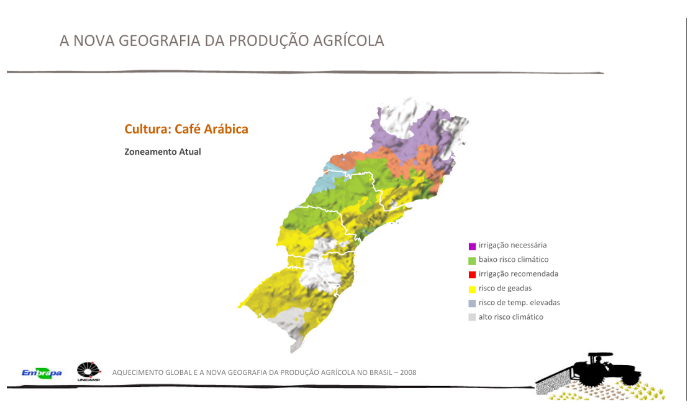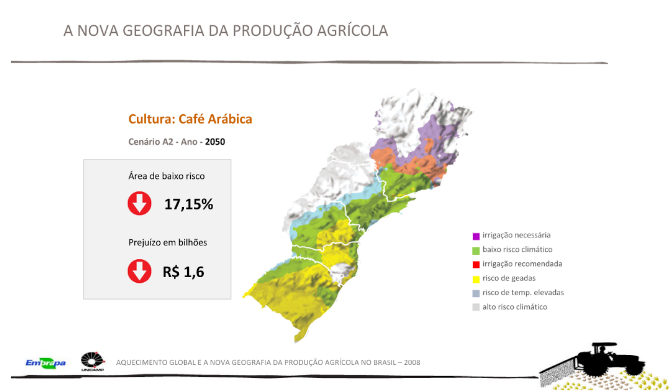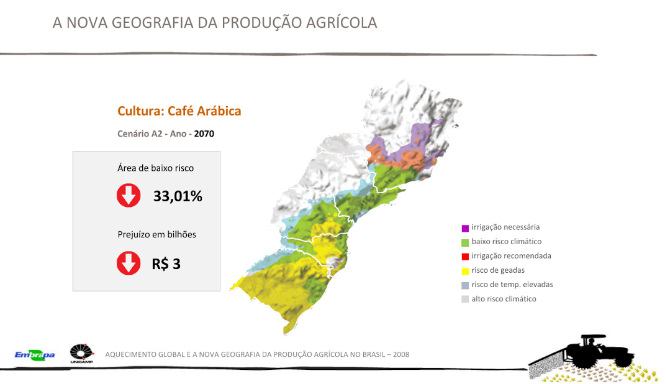We had a conversation with the researchers from Embrapa Informática Agropecuária, Eduardo Assad and Gustavo Rodrigues, to better understand how an increase in temperature can interfere in the Brazilian specialty coffees production. The diagnosis is critical. But reversible.
If the temperatures continue to rise by 0.3 °C (current annual rates) per decade, and if we do not act, we will have a major problem to solve with regard to the Brazilian specialty coffees production. The first one is that the Arabica coffee will suffer much more than the robusta variety. This is the result of the studies done by the Embrapa Informática Agropecuária researchers, Eduardo Delgado Assad and Gustavo Rodrigues.
“The first study we published about this is from 2004, and they almost killed us. They said that we wanted to end the coffee in Brazil, but the truth is that we want to save it”, they say. Some colleagues from other research institutions objected our research results. But recently, those who doubted it, began to realize that the scholars were right and some evidence came to light, such as the abortion of coffee flowers.
How to mitigate the global warming effects?
“Planting trees along the coffee plantations is a perfect way of dealing with global warming, but convincing the coffee farmer to do that is the problem”, he says. “In general, the Brazilian coffee grower is still a highly conservative community today”, warns Eduardo Assad.
“We are experiencing a time of vulnerability in coffee and there are only two options: first, water and shade management, and the second is biotechnology, that is, the species that we use need to be more resistant to heat. We have to increase the resistance of the species used”, explains the researcher.
In Brazil, in general, the large specialty coffee producer would rather continue to use irrigation systems than to plant trees on his property. “Planting trees on producing farms helps lower the local temperature by up to 10 °C. But the big producer does not understand that if the warming continues, there will not be water for everyone. They think that the global warming consequences will not get their way”, argues Eduardo Assad.
The small producer, however, is even more vulnerable. He cannot afford irrigation because it is expensive. “This producer needs to plant trees. Otherwise, it will not thrive”, he warns.
With global warming, two important factors occur in coffee plantations: the first, is that the coffee plant water consumption itself increases since, at high temperatures, the plant perspires more; and the second, is that the elevated temperature is one of the situations in which the flowers abortion occurs, that is, the coffee plant burns.
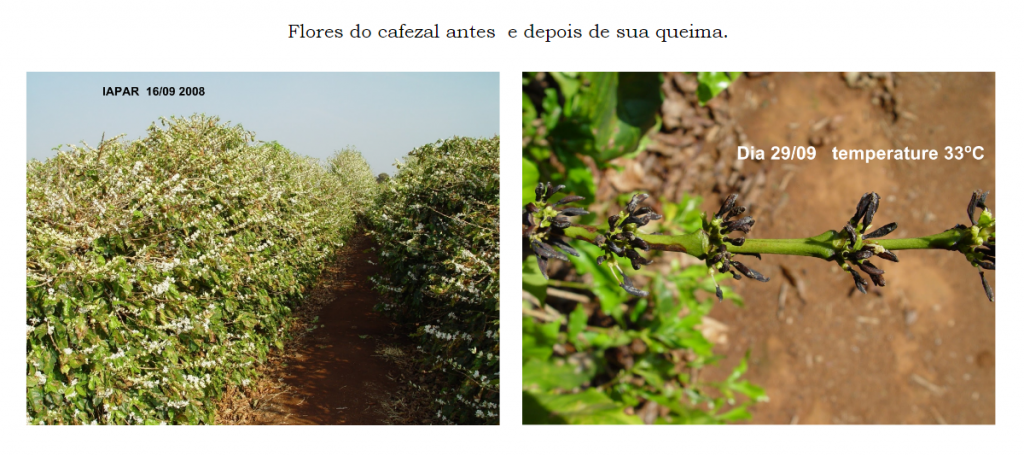
“At the very beginning when the plant starts to have good water and temperature conditions, it releases the bud, commonly known as (chumbinho) pellet in Brazil. However, since we are in a very irregular climate, in the month of August, right after the winter, the temperature begins to warm up and the plant thinks that spring has arrived and begins to release the flower bud. It rains in August/September, the plant thinks it is even better, but when we get to the middle of September and the temperature starts to rise above 34 °C. “This burns the flower bud sepals. This happens within hours, just a certain period of hours with temperatures above 34 °C, to burn everything”, says Gustavo Rodrigues. “The owners of big farms go there and irrigate, they can control the microclimate. But the small producers, who are the vast majority of specialty coffees producers in Brazil, what can they do?
“We are counting the number of days with a temperature above 34 °C. From 1990 to 2017, the curve continues to rise. From 10 days above 34 °C and on, the chance of flower burning increases by 200%. Our main problem with global warming is, in terms of vulnerability, to discover in which producing regions of Brazil this is happening with greater incidence”, they add.
The researchers explain that when the global warming projections are distributed on the map of the great coffee-growing regions of Brazil, the region of low climatic risk, that is, the region where it can be planted normally, has a reduction of 9.8% in coffee production, which means a loss of R$ 888 million per year.
“Embrapa is also researching on the CO2 production increase. So far, the plant gives us hints meaning that the CO2 seems to be beneficial: the plant grows faster. But, we suspect that the cycle may shorten. The coffee plant, instead of lasting 20 years, will last 15. With CO2, temperature and water, the plant will turn into a photosynthesis machine. But it gets to a point where it cannot take any more, it dies. Then you have to replant it and that has a cost”, he explains.
“The specialty coffees from the larger producers use irrigation, to control the abortion with water. But I wanted to remind you that from 1990 on, the state of São Paulo lost 250,000 hectares of coffee, it simply stopped producing arabica coffee. Many regions of the state now plant sugarcane or rubber trees. Or they became cattle farmers”, says Assad.
New coffee producing regions will appear in Brazil
The study also indicates that old coffee producing regions in the country will disappear and others will arise, for example in Rio Grande do Sul. “Even the frosts they have there are dwindling with global warming. In 1970, because of the climatic phenomenon that decimated the coffee plantations in Paraná, the producers were forced to leave their lands and migrate to Minas Gerais to continue living from coffee. Now, with global warming, they prepare to return to Paraná, since the frosts almost never happen there”, warns Assad.
And global warming will not only affect Brazil. Nicaragua, Guatemala and Mexico are already being impacted by the phenomenon. More and more scientific papers are coming out of groups completely different from ours. All concerned with the climate change effects, exemplifies Gustavo Rodrigues.
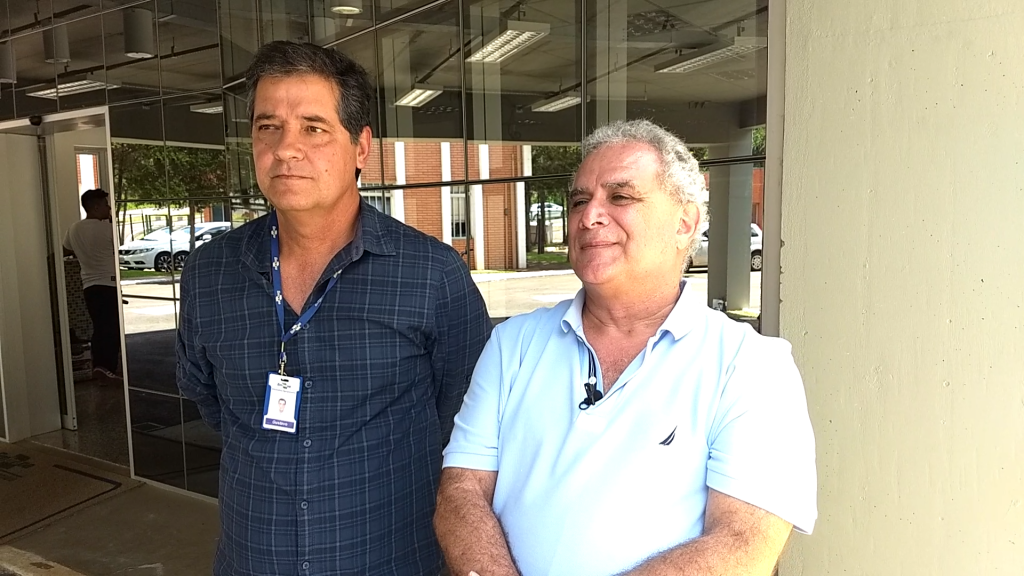
Genetic plasticity
One of the solutions to mitigate the problem is to find a way to develop genetically something that improves the Arabica coffee situation. “By observing these graphs, we have seen that robusta coffee can withstand the increase in temperature. This makes us ponder: can Robusta’s genetic material gives us something that can help the arabica production? One of the options is this. Instead of making a transgenic with another plantation, like the mustard in soy, can we use the same process but with a different variety of coffee? The chance of such project being effective is even larger”, says Assad.
There are already studies, not very focused on the climatic issue, but on production stability. “We have to study the robusta variety. Our great issue is to make the producers stop thinking only in production. It is necessary to think about sustainability. The temperature can increase so much that even large CO2 production is a problem, meaning the plant will not be able to take advantage of the CO2 fertilizing effect, as it is called, says Gustavo.
Ethiopia: an even greater concern
The number of scientific papers on the subject of global warming in coffee plantations being carried out is increasing. There is a group of researchers extremely concerned about the effects of climate change in Ethiopia, North Africa and the genetic origin of coffee.
“At the moment, there is a great loss of coffee diversity in Ethiopia due to climate change. If you want to save the world’s coffee, we need to protect Ethiopia. There are 12,000 different varieties of the plant species. Only 60 species were brought to Brazil. We have to protect the Ethiopian coffee, create a global protection chain, otherwise the coffee will disappear”, says the concerned scientists.
“What I see happening in Ethiopia with global warming is a very large loss of coffee diversity. And all the world has done so far has been to explore Ethiopia, it’s time to protect it. The country should be very rich, as all nations consuming and producing coffee should join in and aid the country by paying for serious studies on the impact of global warming on coffee plantations.
There are 12,000 different varieties of coffee. Only 60 species were brought to Brazil. We have to unite scientists from all over the world and study together with the Ethiopians and pay them fairly. But the people do not want to help black and poor people, racism in the coffee world is still gigantic. If we do not act fast, it’s going to be a disaster, the researchers conclude.

